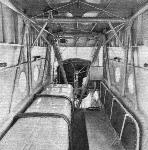
Описание
Страна : США
Год : 1934
Трех-четырехместный бомбардировщик или транспортный гидросамолет
Bellanca Model 77 Bomber
Внимательно изучив успешный опыт разработки и продвижения самолета Model 66 Aircruiser, специалисты компании "Bellanca" решили использовать аналогичную схему и при проектировании военного самолета, предназначенного для поставки на экспорт.
Model 77-140 поднялся в небо в 1933 году, он был спроектирован на базе Aircruiser. Обозначение самолета указывает, что площадь крыла составляет 770 квадратных футов (71,53 м-'), а мощность силовой установки - порядка 1400 л.с. (1044 кВт). Фюзеляж имел в основном прямоугольное сечение и изготавливался из металла с обшивкой из легких сплавов и полотна. Стандартное обтекаемое колесное шасси могло, по желанию заказчика, меняться на поплавковое - в этом случае Model 77-140 превращался в гидросамолет, торпедоносец-бомбардировщик. Экипаж машины составлял три-четыре человека, самолет мог брать на борт до 15 пассажиров или груз.
Два самолета были поставлены в Колумбию, для использования с наземных и гидроаэродромов.
Model 77-320 Bomber являлся модификацией базового самолета и отличался силовой установкой повышенной мощности в составе двух двигателей Wright R-2600. Два таких самолета были также проданы в Колумбию.
ТАКТИКО-ТЕХНИЧЕСКИЕ ХАРАКТЕРИСТИКИ
Bellanca Model 77-320 Bomber
Тип: трех-четырехместный бомбардировщик или транспортный гидросамолет
Силовая установка: два звездообразных поршневых двигателя Wright R-2600 Cyclone 14 мощностью по 1600 л. с. (1193 кВт)
Характеристики: макс, скорость на высоте 1830 м - 362 км/час; крейсерская скорость на оптимальной высоте 322 км/час; практический потолок 8535 м; дальность 1448 км
Масса: пустого 5216 кг; максимальная взлетная 8936 кг
Размеры: размах крыла 23.16 м; длина 13,79 м; высота 6,25 м; площадь крыла 71,53 м
Вооружение: пять 7,62-мм подвижных пулеметов Browning (носовой, надфюзеляжный, подфюзеляжный "туннельный" и два бортовых), а также до 1293 кг вооружения на внешней подвеске (одна торпеда или бомбы)
Описание:
- Bellanca Model 77 Bomber
- Flight, February 1935
AMERICAN ADAPTABILITY
Фотографии
-
Jane's All the World Aircraft 1938 / 03 - All the world's aeroplanes
The Bellanca Twin-engined Bomber (two 715 h.p. Wright "Cyclone" engines).
There is a very distinct resemblance shown by the Bellanca bomber to some of the commercial "heavy-weights" produced by the company. -
Flight 1934-09 / Flight
EXTRAORDINARY: Apparently a development of the "Aircruiser," this latest Bellanca product is a bomber built for the Colombian Government. The all-up weight is 15,000 lb. and the top speed, on the power of two 750 h.p. engines driving adjustable pitch airscrews, is 190 m.p.h. The machine may be fitted with floats and be used as an ambulance.
-
Air International 1984-10 / ??? - Colombia's Air Arm
Колумбийские летчики, как сообщалось, несколько побаивались летать на четырех поставленных в страну самолетах семейства Model 77.
Three of the four float-equipped Bellanca 77-140 bombers that reached Colombia after the Leticia conflict and remained in service until 1942. -
Jane's All the World Aircraft 1980 / Encyclopedia of Aviation - Aircraft A-Z - v2
Bellanca Model 77-140 Bomber seaplane.
-
Flight 1935-02 / Flight
Stressed - skin monocoques have not put the fabric-covered welded structure entirely "out of business." Note, in this view of the Bellanca's cabin, the long-range tank strapped to the floor.
(Bottom -
Flight 1935-04 / Flight
AN OUTSIZE IN AMPHIBIANS: Powered with two geared "Cyclones" of 715 h.p., this big Bellanca amphibian carries eighteen passenger at cruising speed of about 170 m.p.h. There is over fifty cubic feet of baggage space in the stub wings. The machine is a development of the Bellanca bomber, described in Flight, of February, 8 this year.
-
Flight 1935-02 / Flight
Bombs are carried partially buried in the lower wing "stubs" and in the fuselage. The great depth of the fuselage and the disposition of the guns are noteworthy.
- Фотографии






